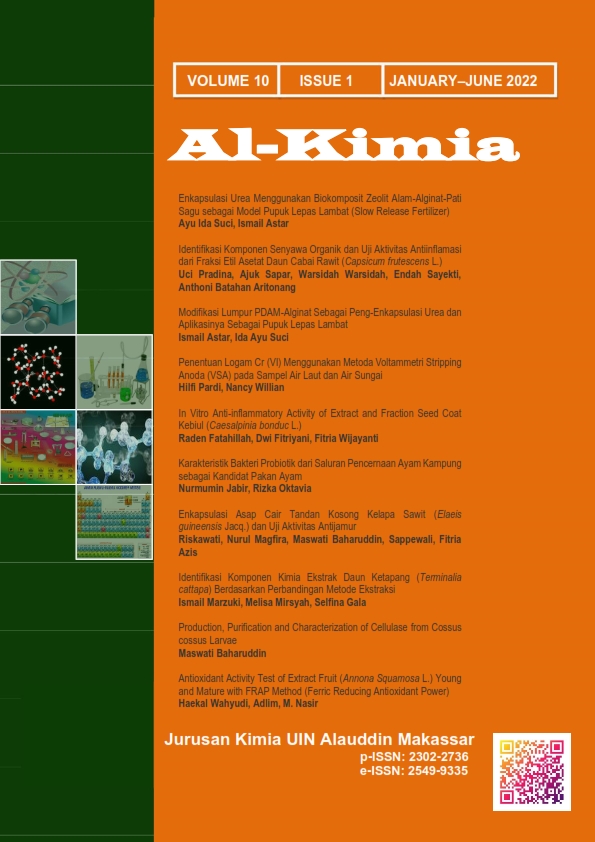Enkapsulasi Urea Menggunakan Biokomposit Zeolit Alam-Alginat-Pati Sagu sebagai Model Pupuk Lepas Lambat (Slow Release Fertilizer)
Abstract
The urea fertilizer was encapsulation with the compositions of natural zeolite-alginate-sago starch biocomposite for developing of slowed-release properties. The characteristics of biocomposites such as FTIR, SEM, and nitrogen release tests were evaluated. Fourier transform infrared spectroscopy showed the presence of natural zeolite-alginate-sago starch biocomposite. The SEM images showed the surface morphology of urea has been coated by natural zeolite-alginate-sago starch biocomposite. Nitrogen release tests on natural zeolite-alginate-sago starch biocomposites with concentrations of 20% was the composition with the best results in holding urea encapsulated. This study indicates that natural zeolite-alginate-sago starch biocomposites are a alternative candidate for the development of the efficient slowed-release formulation of urea.
Downloads
References
Adzmi F, Meon S, Musa MH, Yusuf NA. 2012. Preparation, characterisation, and viability of encapsulated Trichoderma harzianum UPM40 in alginate montmorillonite clay, Journal of Microencapsulation, 29(3), 205–210.
Aviantri F, Maharani D. 2017. Pelepasan nitrogen pada pupuk slow release urea dengan menggunakan matriks kitosan-bentonit, UNESA Journal of Chemistry,6, 1.
Behin J, Nader S. 2016. Utilization of waste lignin to prepare controlled-slow release urea, International Journal Recycle Organic Waste Agriculture, DOI.10.1007/s40093-016-0139-1:1-11.
Bimanto M, Saragih D. 2018. Benefiasi prarancang proses pengolahan pupuk granul slow release dari urea dan zeolite, Prosiding Seminar Instiper 2018, ISBN : 978-602-51151-9-6.
Danarto Y, Nugrahey A, Noviani S . 2017. Kinetika slow release pupuk urea berlapis chitosan termodifikasi, Equilibrium, 16, 2.
Faishol W, Dwiarso R, Laemthong C, Fatimah. 2019. Alginate-modified saponite and study for urea slow released fertilizer application, Rasayan J. Chem, 12, 4, 1792-1802(2019).
Fretes EF, Ing Wardana, Mega NS. 2013. Karakteristik pembakaran dan sifat fisik briket ampas empulur sagu untuk berbagai bentuk dan prosentase perekat, Jurnal Rekayasa Mesin, 4(2),169–176.
He Y, Wu Z, Tu L, Han Y, Zhang G, Li C. 2015. Encapsulation and characterization of slow-release microbial fertilizer from the composites of bentonite and alginate, Applied Clay Science, 109–110.
Ibrahim K, Babadi F, Yunus R. 2014. Comparative performance of different urea coating materials for slow release, Particuology Elsevier,17, 165–172.
Ivanky, Khair, Rizki Tri Wahyudi. 2012. Pembuatan urea Pelepasan Terkendali Melalui Pelapisan Dengan Amilum Menggunakan Teknologi Fluidized Bed Spray, Jurnal Teknologi Kimia dan Industri, Vol.1, No.1. Hal. 64-68.
Jones C, Brown BD, Engel R, Horneck D, Rutz KO. 2013. Management to Minimize Nitrogen Fertilizer Volatilization. Bozeman(US): Montana State University.
Lestary RS, Jayanudin, Irawanto D, Rozak, Wardana, Muhammad. 2020. Preparasi dan karakterisasi kitosan tertaut silang glutaraldehida sebagai matrik pupuk urea, Jurnal Integrasi Proses, Vol. 9, No. 2 (Desember 2020) 27 – 33.
Li A, Zhang J, Wang A. 2007. Utilization of starch and clay for the preparation of superabsorbent composite, Bioresource Technology, 98, 327–332.
Maherawati, Lestari R, Haryadi. 2011. Karakteristik pati dari batang sagu Kalimantan Barat pada tahap pertumbuhan yang berbeda, Agritech, 31(1).
Mayori E, Nadia A, Fauziah A, Sunardi. 2018. Pengembangan teknologi pupuk urea lepas lambat berbasis polisakarida, Prosiding Seminar Nasional Pendidikan Kimia, 20-30. Banjarmasin: FKIP ULM.
Mayori E, Nadia A, Fauziah A, Sunardi. 2018. Karakterisasi biokomposit alginat-pati-kaolin sebagai kandidat Slow-Release pupuk urea, Prosiding Seminar Nasional Lingkungan Lahan Basah, April 2018, Banjarmasin, Indonesia. Halaman 191-195.
Muslim S, Salman, Fitriani L, Netty S, Erizal Z, Febriyenti, Aldi Y, Akmal D. 2015. Use of bioblend polystyrene/starch for coating urea granules as slow release fertilizer, Journal of Chemical and Pharmaceutical Research, 7(11), 478–484.
Nayak, P.L., Sahoo, D., 2011. Chitosan-alginate composites blended with cloisite 30B as a novel drug delivery system for anticancer drug paclitaxel. Int. J. Plast. Technol. 15, 68–81.
Ningtias DR. 2017. Campuran zeolit dan pati sagu sebagai bahan penyalut pupuk urea dan aplikasinya sebagai pelepas-lambat pupuk nitrogen [skripsi]. Bogor: Institut Pertanian Bogor.
Novan A, Maharani D. 2017. Kajian daya serap air (swelling) pupuk urea slow release fertilizer (SRF) menggunakan matriks kitosan-zeolit, UNESA Journal of Chemistry,6, 2.
Pohan M, Sutarno, dan Suyanta. 2016. Studi adsorpsi-desorpsi anion fosfat pada zeolit termodifikasi CTAB, Jurnal Penelitian Sains, 18(3).
Rahmayani R, Arryanto Y, Kartini I . 2019. Pengaruh metode pencampuran pada pembuatan komposit kitosan-zeolite-Fe terhadap pelepasan Fe(III), Jurnal Kimia dan Pendidikan Kimia,4, 3.
Sari EP. 2013. Formulasi pupuk nitrogen lepas lambat tersedia dari bahan urea, zeolit, serta asam humat dan pengaruhnya terhadappPertumbuhan jagung [tesis]. Bogor(ID): Institut Pertanian Bogor.
Styana UIF. 2010. Penggunaan metode coating campuran zeolit dan pati untuk meningkatkan keterikatan nitrogen dan kekuatan pada pupuk granul [tesis]. Yogyakarta: Universitas Gadjah Mada.
Suwardi dan Darmawan. 2009. Peningkatan efisiensi pupuk nitrogen melalui rekayasa kelat urea-zeolit-asam humat. Prosiding seminar hasil-hasil penelitian IPB, Bidang Teknologi dan Rekayasa Pangan, Buku 5 No. 3:525.
Wen P, Wu Z, He Y, Han Y, Tong Y. 2016. Characterization of p(AA-co-AM)/Bent/Urea and its swelling and slow release behavior in a simulative soil environment, Journal Applied Polymer Science, DOI: 10.1002/APP.43082:43082- 43082.
Authors who publish with this journal agree to the following terms:
1) Authors retain copyright and grant the journal right of first publication with the work simultaneously licensed under a Creative Commons Attribution License that allows others to share the work with an acknowledgement of the work's authorship and initial publication in this journal.
2) Authors are able to enter into separate, additional contractual arrangements for the non-exclusive distribution of the journal's published version of the work (e.g., post it to an institutional repository or publish it in a book), with an acknowledgement of its initial publication in this journal.
3)Authors are permitted and encouraged to post their work online (e.g., in institutional repositories or on their website) prior to and during the submission process, as it can lead to productive exchanges, as well as earlier and greater citation of published work (See The Effect of Open Access).


